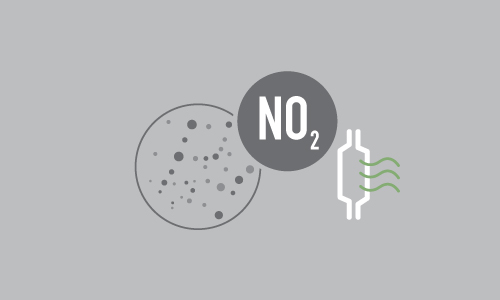Nitrogen oxides (NOx) are common air pollutants emitted during many industrial manufacturing processes. Their emission is controlled by the EPA, and manufacturers are required to control the amount of NOx their processes release into the atmosphere.
What Are Nitrogen Oxides?
NOx occurs mostly in the form of nitric oxides (NOx) and nitrogen dioxide (NO2), both of which are corrosive and hazardous to health.
Nitrogen, in its natural form (N2), is an inert gas that makes up 80% of the air. However, as a single atom, it is quite reactive and can combine with oxygen in the air to form a few different types of oxides under high temperatures.
While combustion engines in automobile account for a substantial portion of NOx emission, there are also many stationary sources. For example, nitric acid manufacturing plants, manufacturers of fertilizers or explosives, and industrial manufacturers (e.g., metallurgical processors, glass manufacturers, cement kilns, power generators, etc.) where high processing temperatures are used.
Why Are Nitrogen Oxides Harmful?
When NOx dissolve in water and decompose, they form nitric acid (HNO3) or nitrous acid (HNO2), which can turn into acid rain, photochemical smog, and ozone accumulation.
NOx can cause inflammation of the airways and respiratory conditions in humans. Long-term exposure can result in decreased lung function, increased risk of respiratory diseases, and heightened response to allergens.
NOx are also involved in the formation of fine particles and ground-level ozone, which can lead to adverse health effects as well as damage vegetations.
Environmental Policies on NOx Control
The Clean Air Act addresses environmental issues such as acid rain, toxic pollutants, and ozone emissions – many of which are associated with NOx emissions.
The federal Environmental Protection Agency (EPA) is responsible for establishing standards and enforcing the Clean Air Act. However, most of the day-to-day activities of regulating emissions happen on the state and local levels.
State and local governments are responsible for devising and enforcing State Implementation Plans (SIPs) to outline how they control emissions and air pollution under the Clean Air Act. SIPs need to have standards that are equal to or exceed the limits set by the EPA and be approved by the agency.
NOx Control for Industrial Manufacturers
Under the Clean Air Act, manufacturers are required to adhere to the emissions standards set by state authorities to avoid incurring fines and penalties.
There are many NOx abatement systems manufacturers can use to reduce NOx emissions, depending on the type of combustions, the form of fuels, and other factors.
Manufacturers can use pollution prevention methods such as low NOx burners, steam/water injection, catalytic combustion, and lean burn; or add-on control technologies such as selective catalytic reduction, non-selective catalytic reduction, and non-thermal plasma reactors.
Choosing the right abatement technologies can help you adhere to emission standards in a cost-effective way. Download our free Air Pollution Control Selection Guide to find the best emission control solution for your manufacturing facility.




